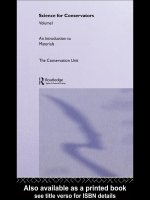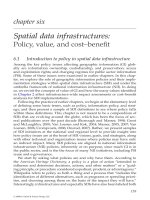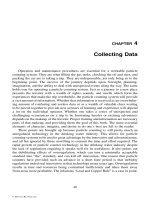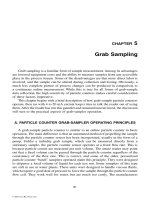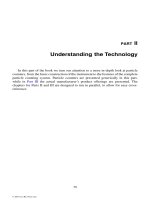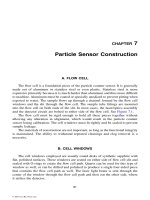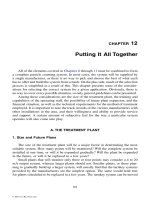INTRODUCTION TO URBAN WATER DISTRIBUTION - CHAPTER 6 pot
Bạn đang xem bản rút gọn của tài liệu. Xem và tải ngay bản đầy đủ của tài liệu tại đây (5.65 MB, 51 trang )
CHAPTER 6
Operation and Maintenance
6.1 NETWORK OPERATION
The consumer’s requirements will not be satisfied in a poorly operated
network, even if it has been well designed and constructed. Making
errors in this phase amplifies the common problems and their implica-
tions that were already mentioned in previous chapters:
– low operating pressures causing inadequate supply,
– high operating pressures causing high leakage in the system,
– low velocities causing long retention of water in pipes and reservoirs,
– frequent changes of flow direction causing water turbidity.
These problems can have a serious impact on public health and coping
with them also influences maintenance requirements and the overall
exploitation costs.
The operation of gravity systems is rather simple and deals with the
balance between supply and consumption, which can be controlled by
operating valves. Pressure limitations in the gravity systems that result
from topographic conditions become even bigger in the case of a bad
design. A wrongly elevated tank, incorrect volume or badly sized pipe
diameter will not guarantee optimal supply, and errors will have to be
corrected by what would otherwise be unnecessary pumping.
In pumped systems, a more sophisticated operation has to be intro-
duced to meet the demand variations and keep the pressures within an
acceptable range. Computer simulations are an essential support in solv-
ing problems such as these. As well as pressures and flows, network
models can process additional results relevant to the optimisation of the
operation, such as: power consumption in pumping stations, demand
deficit in the system, or decay/growth of constituents in the network.
These models are also able to describe the patterns developed during
irregular supply situations. Finally, the models can be linked with moni-
toring devices in the system, which enables the whole operation to be
conducted from one central place.
An example in Figure 6.1 shows a comparison between computer
model output and telemetry (‘ϩ’ markers) for a pressure-controlled
© 2006 Taylor & Francis Group, London, UK
Operation and Maintenance 227
valve. In Figure 6.2, another example of a pumping regime controlled
automatically by the water level variation in a corresponding water tower
is presented. This example indicates clearly the hydraulic link between
the pumping station and the water tower that is filled with the pumped
water until its maximum water level is reached; the pump is switched on
again when the level in the water tower drops to the minimum.
Computerised operation does not necessarily require lots of
expensive equipment when compared to the overall investment cost of
the distribution network. Maintaining this equipment in good condition
is more of a concern, especially if it operates under extreme tempera-
tures, humidity, interrupted power supply, etc. Nevertheless, good
knowledge about the hydraulic behaviour of the system combined with
Figure 6.1. Fitting of the
telemetry and computer model
results (Obradovi-, 1991).
Figure 6.2. Simulated operation
of a pumping station and
corresponding water tower
(Obradovi-, 1991).
© 2006 Taylor & Francis Group, London, UK
228 Introduction to Urban Water Distribution
well-organised work by sufficiently trained personnel will help to save
on both the investment and running costs.
6.1.1 Monitoring
Monitoring of water distribution systems provides vital information
while setting up their operational regimes. It predominantly comprises:
– monitoring of pressure-, water level- and flow variations,
– monitoring of water quality parameters, such as temperature, pH,
turbidity, chlorine concentration, etc.
Pressure-, level- and flow variations can be observed periodically for
specific analyses (e.g. leakage surveys or the determination of a con-
sumption pattern). When monitored continuously, they may indicate:
– operational problems that require urgent action (e.g. pressure drop due
to a pipe burst),
– need for change in the mode of operation, as is the case in Figure 6.2.
Monitoring of water quality parameters can also help to detect inappro-
priate operational regimes. In addition, water quality parameters outside
the normal range often indicate a need for necessary maintenance
(illustrated later in this chapter). As with hydraulic measurements, the
selection of sampling points should provide a good overview of the whole
system, preferably at the source, reservoirs and other easily accessible
locations where long retention times are expected.
Decisions on the spatial distribution of measuring points depend on the
configuration of the system. Pressure- and flow- meters have to be
installed in all the supply points and booster stations. Water levels in the
reservoirs should also be permanently recorded. The measurements in
main pipelines may be registered at critical points of the system (relevant
junctions, extreme altitudes, pressure reducing valves, system ends, etc.).
All these data can be captured in one of the following ways:
Telemetry 1 Telemetry – There is a permanent online communication between the
measuring device and control command centre where the parameter
can be monitored round the clock.
Data loggers 2 Data loggers – Here a measuring device is permanently installed but
the data for certain time intervals are captured periodically and will be
processed and analysed later. Hence, the results of the measurements
are not directly visible.
Local reading 3 Local reading – Direct readings can be obtained from the measuring
devices’ display and immediate action taken if required.
Sampling 4 Sampling – The water sample will be occasionally taken and analysed
in a laboratory.
One example of permanent monitoring station installed on a transmis-
sion main is shown in Figure 6.3.
© 2006 Taylor & Francis Group, London, UK
Operation and Maintenance 229
Table 6.1 gives the recommended order of priority in selecting an
appropriate data capturing method in a water supply system.
Special conditions in the system can sometimes help to draw conclu-
sions about its operation. The following example from The Netherlands
(Cohen and Konijnenberg, 1994) shows the monitoring of the retention
times by measuring natrium concentrations in different spots of the net-
work. Retention times of up to 60 hours were observed in a distribution
area near Amsterdam, during maintenance of its main softening installa-
tion (Figure 6.4). The installation was stopped for 48 hours, which
caused a temporary drop in Natrium concentrations. Obviously, this
Figure 6.3. An on-line
monitoring station at a fixed
location.
Table 6.1. Data capturing methods and points (Obradovi- and Lonsdale, 1998).
Monitoring point Flow Water Pressure Pump Pump Valve Volume Chlorine Turbidity
level status speed opening
Water source T/H T/M T/M
Well pumps T/M L/M L/M
Treatment plant T/H T/H T/M T/M
Main reservoir T/M T/H L/H
Main PST T/H L/H T/L T/M L/H
Local PST T/H L/H T/L L/M L/M
Service reservoir T/M T/H L/H L/M
Booster PST T/M T/L L/M L/M
Control valve T/L T/L T/M
Shut-off valve L/H L/H
Distribution area T/L T/L D/H
Supply zone D/H D/M
Demand district D/H D/L
Control node D/M T/H T/M
Special customer T/H D/H S/
Large customer D/H D/M S/
Ordinary customer D/M D/L S/
X/Y: Method/Priority
X: T – Telemetry, D – Data loggers, L – Local instruments, S – Sampling
Y: H – High, M – Medium, L – Low
© 2006 Taylor & Francis Group, London, UK
230 Introduction to Urban Water Distribution
effect could be registered sooner in the points located closer to the source
(Figures 6.5 and 6.6).
6.1.2 Network reliability
A network is reliable if it can permanently perform in accordance with
the design criteria. In reality, due to unforeseen events, this is never
the case. It is therefore more realistic to define network reliability as a
probability of guaranteed minimum quantity, supplied in any (irregular)
situation.
Figure 6.4. Retention times in a
distribution network (Cohen and
Konijnenberg, 1994).
7 11
Point 3
15
13/4 14/4
19 23 3 7 11 15
Hours
Na-concentration (mg/l)
65
71
77
83
89
95
Point 5
Figure 6.5. Drop in Na-
concentration as a result of hard
water in the system (Cohen and
Konijnenberg, 1994).
© 2006 Taylor & Francis Group, London, UK
Operation and Maintenance 231
When interruptions occur, consumers are normally not concerned with
the cause, but rather with the consequences. Accordingly, the irregular
events can be classified as failures, calamities or disasters. In the case of
failures, a local interruption of the supply area will be caused. These are
usually breaks in the distribution pipes that can be repaired within
24 hours. Failure of some major system component (a pumping station,
or main transmission line) is considered as a calamity, which will affect
a larger number of consumers and in most cases for more than 24 hours.
An event involving the simultaneous failure of major components is
treated as a disaster.
Temporary shortages of supply can appear due to:
– pipe breakage,
– power or mechanical failure in the pumping station,
– deterioration of the raw water quality (source),
– excessive demand in other parts of the network,
– maintenance or reconstruction of the system.
Pipe breakage is the most difficult to prevent because of the wide range
of potential causes. Table 6.2 shows the statistics for some European
cities (main pipes only). The data in it offer different pictures about
leakages depending on the way they are presented. For instance, three
times less bursts are observed in the network of Zurich in Switzerland
compared to Vienna in Austria, while at the same time the number of
leaks per 100 km of the network is higher in Zurich.
The bursts occur more often with smaller pipes and service connec-
tions, but create a rather insignificant impact on the overall water loss
and hydraulic behaviour of the system. Reasonably accurate predictions
can be derived from local observations of the event occurrence. The type
of relation between the number of bursts and pipe diameters will be as
shown in Figure 6.7 in most cases.
Failures
Calamities Disasters
0 5 10 15 20 1 6 11 16 21
pH
13/4 14/4
Hours
In operation
20.00 hour
pH (-)
7
7.4
7.8
8.2
8.6
9.0
Na-concentration
(
m
g
/l
)
60
68
76
84
92
100
Na concentration
12 hour
The first hard water appears at 2.30 hour
*
*
Figure 6.6. Comparison
between Na-concentration and
pH-values in the system (Cohen
and Konijnenberg, 1994).
© 2006 Taylor & Francis Group, London, UK
232 Introduction to Urban Water Distribution
Concerning the type of materials, in general, corrosion-attacked
pipes are the least reliable. However, these experiences are not transfer-
able in practice, and keeping local records about the system failure is
an essential element of reliability analyses. The records for the three
types of pipe materials mostly used in The Netherlands are given in
Figure 6.8.
Table 6.2. Pipe burst occurrences (Coe, 1978).
City, Country Total bursts Bursts per
per annum 100 km pipes
Vienna, Austria 1700 47
Salzburg, Austria 83 18
Antwerp, Belgium 225 13
Copenhagen, Denmark 100 12
Helsinki, Finland 116 14
Frankfurt, Germany 600 40
Rotterdam, The Netherlands 400 19
Oslo, Norway 320 27
Barcelona, Spain 2850 115
Zurich, Switzerland 550 56
0 100 200 300 400 500 600
D
(
mm
)
700
Number of bursts/year/km
0.0
0.1
0.2
0.3 0.3
0.4
0.5
Figure 6.7. Bursting frequency
of pipes of various diameters.
CI
PVC
AC
0 5 10 15 20 25
50-100
100-150
150-200
>200
D (mm)
Bursts/100 km/year
Figure 6.8. Average frequency
of pipe bursts in The
Netherlands (Vreeburg et al.,
1994).
© 2006 Taylor & Francis Group, London, UK
According to this diagram, CI pipes appear to be the most vulnerable;
in this particular case for well-known reasons. These were the first
generation pipes (laid before Ϯ70 years), while AC and PVC pipes
belong to the second and third generation of the twentieth century
(Ϯ40 and 20 years old, respectively). Apart from these pipes, experience
with the latest materials (PE, GRP) is too short to draw firm conclu-
sions yet.
A simplified method for assessing the network reliability is based on
the following formula:
(6.1)
where Q
f
represents the available demand in the system after the failure,
against the original demand Q
o
. The effects of the failure expressed in
reduction of supply can be foreseen by running computer simulations.
This is normally done for maximum supply conditions and without
selected components in operation. The assessment requires repetitive
calculations but apart from that, the results can accurately point out weak
points in the system. The burst of a pipe carrying large flows always has
more far-reaching adverse consequences on the pressures and flows in
the system than the burst of some small or peripheral pipe. For a more
complex consideration of reliability, the failure frequency and average
time necessary for repair may also be included.
A practical method of this type is suggested by Cullinane (1989), who
defines the nodal reliability as a percentage of time in which the pressure
at the node is above the defined threshold. It is known as the hydraulic
reliability and reads as follows:
(6.2)
where R
j
is the hydraulic reliability of node j, r
ij
is the hydraulic
reliability of node j during time step i, t
i
is the duration of time step i,
k is the total number of the time steps, T is the length of the simulation
period. Factor r
ij
takes value 1 for the nodal pressure p
ij
equal or above
the threshold pressure p
min
, and r
ij
ϭ 0 in case of p
ij
Ͻ p
min
. For equal
time intervals, t
i
ϭ T/k.
The reliability of the entire system consisting of n nodes can be
defined as the average of all nodal reliabilities:
(6.3)R ϭ
͚
n
jϭ1
R
j
n
R
j
ϭ
͚
k
iϭ1
r
ij
t
i
T
Hydraulic reliability
R ϭ 1 Ϫ
Q
o
Ϫ Q
f
Q
o
Operation and Maintenance 233
© 2006 Taylor & Francis Group, London, UK
234 Introduction to Urban Water Distribution
The above equations assume that all network components are fully
functional, which is rarely the case. The expected value of the nodal
reliability can be determined as:
(6.4)
where RE
jm
is the expected value of the nodal reliability while consider-
ing pipe m, A
m
is the availability of pipe m, i.e. the probability that this
pipe is operational, U
m
is the unavailability of pipe m, U
m
ϭ 1 Ϫ A
m
, R
jm
is the reliability of node j if link m is available, i.e. in operation and R
j
is
the reliability of node j if link m is not available, i.e. not in operation. The
component availability can be calculated on an annual basis from the
following equation:
(6.5)
where CMT represents the annual corrective maintenance time in hours
and PMT is the annual preventive maintenance time in hours. These
figures should be available from the water company records.
The values of R
jm
and R
j
in Equation 6.4 are determined from
Equation 6.2, running the network computer simulation once with the
link m operational and then again, by excluding it from the layout.
A single transportation pipe has practically no reliability as any burst
will likely result in a severe drop in supply and pressures; during repair
all downstream users will have to be temporarily disconnected
(Figure 6.9).
A burst in the case of parallel pipes causes a flow reduction depen-
dant on the capacity of the pipe/pumping station remaining in operation,
A
m
ϭ
8760 Ϫ CMT Ϫ PMT
8760
RE
jm
ϭ A
m
R
jm
ϩ U
m
R
j
0%
50%
Reliability
Burst
90%
Figure 6.9. Reliability
assessment.
© 2006 Taylor & Francis Group, London, UK
Operation and Maintenance 235
say 50%. Further improvement of the reliability will be achieved by
introducing the following technical provisions:
– parallel pipes, pipes in loops, cross connections,
– pump operation with more units,
– alternative source of water,
– alternative power supply,
– proper valve locations,
– pumping stations and storage connected with more than one pipe to
the system,
– reservoirs with more compartments,
– bypass pipes around the pump stations and storage etc.
A few examples of possible cross-connections are shown in Figure 6.10.
In long transmission lines, these are usually constructed every 4–5 km,
in distribution mains every 300–500 m and in rural areas every 1–2 km.
Setting the standards in technical measures that can improve the
network reliability is rather difficult due to the variety of situations and
consequences that can occur. Nevertheless, some guidelines may be for-
mulated if there are more serious failures. For instance, the Dutch
Waterworks Association (VEWIN) proposes 75% of the maximum daily
quantity as an acceptable minimum supply in irregular situations. This
should be applicable for a district area of Ϯ2000 connections. Within
such an area, valves should be planned to isolate smaller sections of
10–150 connections, when necessary.
6.1.3 Unaccounted-for water and leakage
Unaccounted-for water The charged water quantity will always be smaller than the supplied
amount. Moreover, the volume of water actually consumed is also
JunctionParallel mains
Crossing Complex crossing
Figure 6.10. Technical
provisions for improvement of
reliability (van der Zwan and
Blokland, 1989).
© 2006 Taylor & Francis Group, London, UK
236 Introduction to Urban Water Distribution
smaller than the supplied amount, be it charged or not. The difference in
the first case refers to the unaccounted-for water (UFW) while the
second one represents leakage. Leakage is usually a major factor of
UFW. Other important factors can be faulty water meters, illegal
connections, the poor education of consumers etc.
Non-revenue water In more recent terminology, the difference between the supplied and the
charged quantity is defined as non-revenue water (NRW), whilst the
unaccounted-for water is the part of NRW that remains after deducting
unbilled but authorised consumption. Examples of such consumption are
the water used for backwashing of filters, flushing of pipes, washing
streets, fire fighting, public taps and fountains, parks etc. The volume
used for these purposes is usually marginal compared to the total water
supplied, which makes the difference between UFW and NRW small in
many systems. A structure of the total system input volume is shown in
Table 6.3. For more details on the terminology see IWA (2000).
Magnitude and causes
There are two usual ways of expressing unaccounted-for water:
1 as a percentage of (annual) water production,
2 as a specific value, in m
3
/d per m length of the network.
Comparison between these two approaches may lead to conflicting
conclusions, as the example of records for a number of countries in
Figure 6.11 shows. The gross UFW percentage does not necessarily
coincide with the UFW quantities spread over the length of the network.
Table 6.3. Structure of a water supply system input volume (IWA, 2000).
Billed metered
Billed authorized consumption (including
consumption exported water) Revenue water
Authorised Billed unmetered
consumption consumption
Unbilled authorized Unbilled metered
consumption consumption
Unbilled unmetered
consumption
Apparent losses Unauthorised
(Commercial losses) consumption
Metering inaccuracies Non-revenue water
Water losses Leakage in transmission
(UFW) and distribution lines
Real losses Leakage and overflows
(Physical losses) at storage tanks
Leakage on service
connections up to
customer meters
© 2006 Taylor & Francis Group, London, UK
Operation and Maintenance 237
The statistics on UFW show very high figures for many cities in the
developing countries where water is often scarce. The examples are
shown in Figures 6.12 and 6.13.
Besides leakage, a significant impact on UFW in the developing
countries frequently comes from the malfunctioning of water meters,
their inaccurate and irregular reading, or from illegal connections.
All these contribute to the high UFW levels, as shown in Table 6.4
(Thiadens, 1996).
Similar figures in the developed world are much lower. Typically,
the UFW levels in the Western Europe are between 5% and 15%.
%
m
3
/d/km
m
3
/km
%
0 10 20 30 40 50
05025 75 100 125 150
60
Singapore
Murcia, Spain
Tokyo, Japan
Bangkok, Thailand
Bogota, Colombia
Santiago, Chile
Sao Paulo, Brazil
Figure 6.11. UFW statistics
(World Bank, 1996).
Figure 6.12. UFW in some
countries of the MENA Region
(World Bank, 2000).
© 2006 Taylor & Francis Group, London, UK
238 Introduction to Urban Water Distribution
The breakdown of the volume distributed in the city of Nuremberg in
Germany is given in Table 6.5 (Hirner, 1997).
In numbers, the leaks most often occur at service connections.
However, these result in small water losses, eventually paid for by
consumers in many cases. For that reason, water companies are more
concerned by losses in the distribution system that may pass unattended
for a long period of time.
Common factors influencing leakage can be split in two groups.
The first deals with soil characteristics and the corresponding human
activities; the main factors in this group are:
– soil movement and aggressiveness,
– heavy traffic loadings,
UFW (%)
0 10 20 30 40 50 60 70
Karachi
Delhi
Johor Bahru
Male
Singapore
Kathmandu
Manila
Jakarta
Phnom Penh
Hanoi
Figure 6.13. UFW in some
Asian cities (ADB, 1997).
Table 6.4. Main components of UFW in developing countries (Thiadens, 1996).
UFW components Bandung Chonburi Petaling Jaya
(Indonesia) (Thailand) (Malaysia)
Trunk mains,
distribution 21 2 2
Physical losses (%) system
Service
connections 10 34 17
Illegal
connections 6 2 2
Meter under-
registering 6 8 15
and billing
Total UFW 43 46 36
Non-physical
losses (%)
© 2006 Taylor & Francis Group, London, UK
Operation and Maintenance 239
– damage due to excavations,
– damage due to the growing roots of plants.
The second group of factors deals with the system components, its
construction and operation. Here, the main factors are:
– pipe age, corrosion, and defects in production,
– high water pressure in the pipes,
– extreme ambient (winter) temperatures,
– poor quality of joints,
– poor quality of workmanship.
In many cases the leaks are related to the type of soil. In that respect, the
most favourable conditions will be met in sandy soils. Figure 6.14 shows
the German experience of acceptable levels of leakage in various types
of soils (Weimer, 1992).
Leak detection methods
Global estimates of leakage come from an annual balance of the deliv-
ery and metered consumption for the whole network. Bursts of main
Table 6.5. The breakdown of the volume distributed in Nuremberg, Germany (Hirner, 1997).
Charged water – 84.8
Accounted for water – 91.3 (%) Bulk supply water – 6.2
Public use (park, fountains, etc.) – 0.3
Unmetered usage – 0.5
Apparent losses – 3.5 Own waterworks consumption – 1
Unaccounted for water – 8.7 (%) Meter errors – 2
Real losses – 5.2 Pipe breaks – 3.5
House connections – 1.7
Loam Sand-loam Sandy Gravel stony-faulty
Upper sector = Upper range
Cohesive Non-cohesive
m
3
/h/km
Acceptable leakage
0.0
0.1
0.2
0.3
0.4
0.5
0.6
Lower sector = Lower range
Figure 6.14. Leakage in various
soil types (Weimer, 1992).
© 2006 Taylor & Francis Group, London, UK
240 Introduction to Urban Water Distribution
pipes can be detected by the flow measurements at supply points
(Figure 6.15).
The earlier information is not based on specific monitoring of leaks.
To enable leak detection, parts of the system have to be inspected over a
period of several hours or days, depending on the size of the district.
These temporary measurements are usually carried out overnight, when
real consumption and overall noise level are at a minimum. A flow meter
can be permanently installed, or a van with the equipment is brought to
the location (see Figure 6.16). The area will be isolated from the rest of
the system by closing the district valves and its in- and out-flow will be
measured. The company would normally possess some records on the
night consumption in the area. Everything that is detected in addition to
that is a form of UFW, mostly leakage.
Time (days)
Flow (m
3
/d)
0
25
27 29 31 2
First burst
Second burst
4 6 8 10 12 14 16 18 20 22 24
400
800
1200
1600
2000
Figure 6.15. Leak detection
from the demand monitoring.
Water analysis
(minimum night flow)
Leak detection
and repair
Processing
Flow
meter
Fixed connection to the
network (or mobile van)
Closed
valves
Figure 6.16. District monitoring
of night flow.
© 2006 Taylor & Francis Group, London, UK
Operation and Maintenance 241
The measurements can be repeated in weekly intervals throughout a
period of a few months. Possible pipe burst between the two measure-
ments should be reflected in a sudden increase in registered demand.
The average leakage level can also be estimated by measuring pres-
sures in the system, once the relation between the pressure and night
flow has been established. The method shown in Figure 6.17 is applied
in England (Brandon, 1984). The example in the figure shows how
reducing the pressure from 70 to 38 mwc cuts the leakage to half of the
existing level.
Flow and pressure measurements do not indicate the exact location of
leaks. In the case of severe breaks, water may appear on the surface, but
more often leak detection techniques have to be applied. The most
popular are:
1 acoustic (sound) method,
2 leak noise correlation,
3 tracer techniques.
Acoustic detectors Acoustic detectors rely on sounding directly on the pipe or fitting, or
indirectly on the ground surface. The noise generated from the leak is
transmitted by the receiver attached to the stick, to the amplifier con-
nected with the stethoscope (Figure 6.18). This method is not always
reliable due to the fact that some leaks produce undetectable noise.
Moreover, locating the pipe route is much more difficult in the case of
plastic and concrete pipes than in the case of metal pipes, as already
Average zone night pressure (mwc)
Leakage index
0
10
20
30
40
50
60
70
80
90
100
0
20 40 60 80 100
Present level
Proposed level
Figure 6.17. Pressure-leakage
relation (Brandon, 1984).
© 2006 Taylor & Francis Group, London, UK
242 Introduction to Urban Water Distribution
shown in Tables 4.6. and 4.7 Nevertheless, with skilled personnel working
under silent (night) conditions, most of the leaks in metal pipes can be
discovered.
Correlation method Another method based on sound detection is the correlation method
(Figures 6.19 and 6.20). This method uses the constant sound propaga-
tion in water, which happens at a speed of Ϯ1240 m/s, for detection of
leakage. By placing the microphones at the ends of the controlled sec-
tion, the difference (t) in time required for the leak noise to reach the
microphones can be measured by a device called a correlator. For the
known length L of the section, position a of the leak can be calculated.
This method is fairly effective in detecting leaks under high background
noise levels and can therefore be applied during the daytime. As in the
case of acoustic detectors, it might be less successful in the case of
non-metal pipes or if more than one leak exists along the inspected
pipe route.
Figure 6.18. Leak detection by
the acoustic method.
L = Section length
a = Leak location
v = Sound propagation 1240 m/s
t = Time delay in signals from sensors A & B
a
v
A
B
a
t
(L–a)
v
(L–a)
Figure 6.19. Correlation
method – principle.
Correlator
© 2006 Taylor & Francis Group, London, UK
Operation and Maintenance 243
Apart from ambient noise and pipe material, other factors generally
affecting acoustic leak detection are low water pressure, variations in
pipe depth or properties of bedding material, mixture of different soils
and a high groundwater table.
Tracer method The tracer method involves a gas being pressure-injected into the main
that is under inspection; this main will be isolated from the rest of the
system for this purpose. As water leaks, its pressure reduces to atmos-
pheric level and the gas comes out of the solution. The presence of the
gas is then tested by using the gas detector probe inserted into the holes
made along the known pipe route (Figure 6.21).
A gas frequently used as a tracer is nitrous oxide (N
2
O), being non-
reactive, non-toxic, odourless and tasteless. It is soluble in water and can
be registered in very small concentrations. Other gases can also be used,
Figure 6.20. Correlation
method – equipment
(Manufacturer: Biwater-
Spetrascan).
25-40 mm bar holes every 3-5 m
Flow meter
Flow regulation valve
Nitrous oxide supply
Flow
Probe
Nitrous
oxide detector
Portable
generator
Figure 6.21. The tracer method.
© 2006 Taylor & Francis Group, London, UK
244 Introduction to Urban Water Distribution
e.g. sulphur hexafluoride (SF
6
). Work with gas tracers in US includes the
inspection of empty pipes that can be pressurised by helium or nitrogen.
Depending on the conditions, drilling of the probes might be avoided in
this case (Smith et al., 2000).
The tracer methods are generally more expensive than the acoustic
methods. Their advantage is that they are not dependent on the condi-
tions required for acoustic leak detection. Furthermore, they can be used
for locating bursts in empty pipes, which may sometimes be required for
emergency reasons.
Organisation of the leak survey programme
There are various levels of treating the leakage problems. For leakage
levels above Ϯ30%, organisation of the leak survey and metering pro-
gramme (LSM) is usually justified in the savings obtained. Below that
level, an economic study should be carried out taking into consideration
the costs of production, distribution and leakage control. The conditions
of water sources are also a relevant element for the final decision. At the
very least, by reducing the leakage level, an investment in the system
extension can be postponed by several years (Figure 6.22).
Figure 6.23 shows the reduction of leakage applying different levels of
control (Brandon, 1984). By the passive method, only the major leaks and
leaks being reported by the consumers are repaired: the reactive approach,
in which no systematic effort is made to measure or detect leakage.
Regular sounding is not considered to be the main component of
the leakage detection procedure. When it is not selective, this method
Figure 6.22. Savings obtained
by the leakage reduction.
© 2006 Taylor & Francis Group, London, UK
Operation and Maintenance 245
requires a lot of manpower with sometimes unreliable results. Therefore,
it is better to apply sounding techniques at a local level where leakage
has already been indicated by measurements.
The most efficient (and expensive) approach includes prevention and
reaction. Once the decision has been taken about systematic leak detec-
tion, a good organisation of the activities is required. A good organisa-
tional setup of a leak detection team in a water supply company can be
as shown in Figure 6.24.
The main components of the leakage detection programme are:
1 data collection,
2 planning,
3 organisation,
4 leak survey and repair.
The data collection comprises information about:
– pipes: route, material, dimensions, age,
– measuring devices,
– valves and fire hydrants,
– service connections.
After this has been completed and evaluated, the next step is planning,
comprising:
– preparation of operational charts for specific activities,
– selection of type and quantity of the equipment needed,
– planning of a training programme for personnel,
– determination of the priorities among the areas surveyed.
Low
Passive leakage control
Medium High
Intrinsic leakage levels
Net night flow (l/property/hr)
0
4
8
12
16
20
24
28
Regular sounding
District metering
Waste metering and combined metering
Figure 6.23. Levels of leak
control.
© 2006 Taylor & Francis Group, London, UK
246 Introduction to Urban Water Distribution
The organisational stage consists of:
– selection and training of the personnel,
– procurement of the equipment.
Finally, the leak survey can commence. The economic viability of the
leakage survey programmes is evaluated based on:
– total amount of water loss due to leakage,
– minimum acceptable leakage percentage,
– total cost of water production,
– maximum saving if the minimum acceptable leakage can be achieved,
– investment and labour costs involved in the leakage detection
programme,
– maintenance of the system at the minimum-acceptable leakage,
– the amount of water saved by the programme.
Water meter under-reading
If not regularly maintained and replaced, water meters may register
inaccurate amounts of water. According to statistics, water meter under-
reading is the second main source of UFW after leakage in the vast
majority of countries.
Chief engineer
Water undertaking
Chief officer:
Treatment plant
Chief officer:
Pumping stations
Chief officer:
Administration
Chief officer:
Distribution network
Unit chief:
Maintenance
and repair
Unit chief:
Pipe extensions and
construction; installing
water meters
Unit chief:
Inspection of
plumbing system and
meter reading
Unit chief:
Maintenance of
water meters
Unit chief:
Systematic
leak survey
Leak surveyors Leak survey crew:
one foreman
one driver
two fitters
two labourers
Leak survey crew:
one foreman
one driver
two fitters
two labourers
Assistant
unit chief:
Figure 6.24. Leak detection team setup (KIWA, 1994).
© 2006 Taylor & Francis Group, London, UK
Operation and Maintenance 247
The accuracy of water meters reduces after a few years in operation
(see Figure 6.25). A severe drop in the accuracy of the measurements can
occur as soon as five years of operation. This is particularly emphasised
in the lower range of flow rates. The lack of accuracy of water meters may
cause serious revenue losses for water companies. Therefore, the measur-
ing devices have to be regularly controlled, and if necessary repaired and
re-installed (the average cost in The Netherlands is 10–15 US$ per piece),
0
10
20
30
40
50
60
70
80
90
100
110
120
130
140
150
Litres
p
er hour
Error %
–100
–80
–60
New
2
4
6
8
10
12
Old
–40
–20
0
Figure 6.25. Drop in accuracy
of water meters in operation.
0 2 4 6 8 10 12 14
Years between meter exchanges
Cost of meter renewal per annum
Potential loss of revenue per annum
Cost to undertaking
Figure 6.26. Economics of
meter exchange periods.
© 2006 Taylor & Francis Group, London, UK
or renewed (US$ 30–35 per piece). The choice between the two options
will depend on the cost evaluation of each renewal and increased water
loss due to malfunctioning (Figure 6.26). The economic period varies
between 6 and 12 years and in exceptional cases longer; most commonly
water meters are replaced every 8–10 years.
Water meters are sometimes installed within the premises. The fact
that the real amount of water used is paid for increases awareness of the
consumers. However, this principle is not always economical. It requires
additional investment in equipment and personnel involved in installa-
tion, maintenance, replacement, reading and administration. The final
decision normally depends on local conditions such as: average water
demand, network coverage, labour costs, ability of the consumers to pay
the bill, etc. Usually, the cost of individual metering is born fully or
partly by the consumers.
6.1.4 Corrosion
Corrosion causes deterioration of material properties due to reaction
with its environment. In water transport and distribution, this process
takes place predominantly attacking pipes and joints, defined as:
– external corrosion, in reaction with the soil,
– internal corrosion, in reaction with water.
Concerning the materials, two types of corrosion can be distinguished:
1 metallic corrosion,
2 corrosion of cement-based products.
Metallic corrosion is a chemical reaction caused by the transfer of elec-
trons (Figure 6.27). After a metal ion leaves the pipe surface (anodic site)
and enters water, excess electrons migrate through the metal to a
cathodic site where they are used by a balancing reaction. Three types of
reactions are possible:
1 hydrogen evolution – typical in aggressive waters (with low pH),
2 oxygen reduction – typical in normal waters,
3 sulphate reduction – typical for the anaerobic conditions occurring
in soils.
The direct consequence is that the pipe will lose its mass at the anodic
site, which will be partly dissolved and partly accumulated at the
cathodic site. Practical problems resulting from this are:
– loss of water and pressure due to leakages,
– increased pumping costs due to pipe clogging,
– malfunctioning of appurtenances in the system,
– malfunctioning of indoor installations,
– the appearance of bad taste, odour and colour in the water.
248 Introduction to Urban Water Distribution
© 2006 Taylor & Francis Group, London, UK
Operation and Maintenance 249
The corrosion of cement-based (or lined) materials is a chemical
reaction in which the cement is dissolved due to the leaching of calcium
at low pH values (in principle less than 6.0). This can be a problem in the
case of cement-lined metal pipes but also with concrete or AC pipes,
where the structural strength of the pipe may be lost or a metal (rein-
forcement) can be exposed to the water enhancing the corrosion process
even further.
Corrosion forms
The actual mechanisms of corrosion are usually the interrelation of
physical, chemical and biological reactions. Common forms of pipe
corrosion are (AWWA, 1986):
Galvanic corrosion Galvanic corrosion: When two different pipe metals are connected, the
cathodic site tends to be localised on the less reactive material, and the
anodic on the more reactive, causing corrosion known as galvanic cor-
rosion. This kind of corrosion is typical at joints of indoor installations
(e.g. copper pipe connected to galvanised iron causes corrosion of iron).
The galvanic corrosion can be particularly severe at elbows.
Pitting Pitting: This is localised, non-uniform corrosion hardly detectible
before a hole appears. This is a potentially dangerous form of corrosion
because even small holes may cause rapid pipe failure. Surface imper-
fections, scratches or deposits are favourable places for pitting corrosion.
Tuberculation Tuberculation: Tuberculation occurs when pitting corrosion builds up at
the anode next to the pit. Tuberculation rarely affects the water quality
Metal dissolution
Metal dissolution (acids)
2H
+
+ 2e 2H h
2
1
Oxygen reduction (natural waters)
O
2
+ H
2
O + 4e 4OH
–
2
Bacterial (anaerobic)
8H
+
+ 8e + SO
4
S
–
3
e = Electron flow
e
Iron
Cathode
A
node
Water reactions
Fe
2+
+ 4H
2
O
Figure 6.27. Metallic corrosion.
© 2006 Taylor & Francis Group, London, UK
250 Introduction to Urban Water Distribution
unless some of the tubercles are broken due to sudden changes in flow.
Serious forms of this corrosion would lead to a drastic increase of pipe
roughness, i.e. reduction in the inner diameter. Hence, this type of cor-
rosion can be suspected by monitoring the hydraulic performance of the
pipe. An example in Figure 6.28 shows the effects of tuberculation on the
reduction of the cross section area of the CI pipes in the same distribu-
tion network. The percentage indicates the remaining area of the pipe
cross-sections.
Crevice corrosion Crevice corrosion: A form of localised corrosion usually caused by
changes in acidity, oxygen depletion, dissolved ions etc. Crevices appear
at joints or surface deposits.
Erosive corrosion Erosive corrosion: By this corrosion a protective coating against corro-
sive attack is mechanically removed due to high velocities, turbulence or
sudden changes in flow direction. Pieces of the pipe material can be
removed, as well. This corrosion form is common at sharp bends.
Cavitation corrosion Cavitation corrosion: This is a type of erosion corrosion caused by the
collapse of vapour bubbles (most often at pump impellers, as explained
in Chapter 4). It occurs at high flow velocities immediately following a
constriction or a sudden change in direction.
Biological corrosion Biological corrosion: The reaction between the pipe material and micro
organisms that appear in pipes results in this form of corrosion.
Biological corrosion is common in stagnant waters and at dead ends of
networks. It is an important factor in the taste and odour problems that
develop, but also in the degradation of the material. Control of biologi-
cal growth is very difficult because it can appear in many protected
areas (e.g. in accumulations of corrosion products) where disinfection by
chlorine or oxygen is inefficient.
Corrosion and water composition
Water composition is a key factor that influences internal pipe corrosion.
Much effort has been put into establishing the quantitative relationship
Figure 6.28. Effects of
tuberculation on the reduction
of the pipe cross-section
(Courtesy Prof. V.L. Snoeyink,
University of Illinois).
© 2006 Taylor & Francis Group, London, UK
